

5 biophilic UX solutions for a sustainable future
source link: https://uxdesign.cc/5-biophilic-ux-solutions-for-a-sustainable-future-5d58a217649c
Go to the source link to view the article. You can view the picture content, updated content and better typesetting reading experience. If the link is broken, please click the button below to view the snapshot at that time.
5 biophilic UX solutions for a sustainable future
Why 2022 will matter for climate action in 50 years of climate action (source: UN)
On these exact dates in 1972, the first world conference on the environment drew the attention on the need for environment protection. Then, the next world conference and subsequent naming of the Earth Summit was held at Rio de Janeiro, Brazil in 1992. The United Nation and participating countries established a double focus on environment and development, creating milestone treaties such as the UN Framework Convention on Climate Change (UNFCCC) and the UN convention on Biological Diversity (CBD), to address climate change and biodiversity respectively. Fast forward to 2022, after fifty years, and we are at the inflection point to make a positive change for our world.
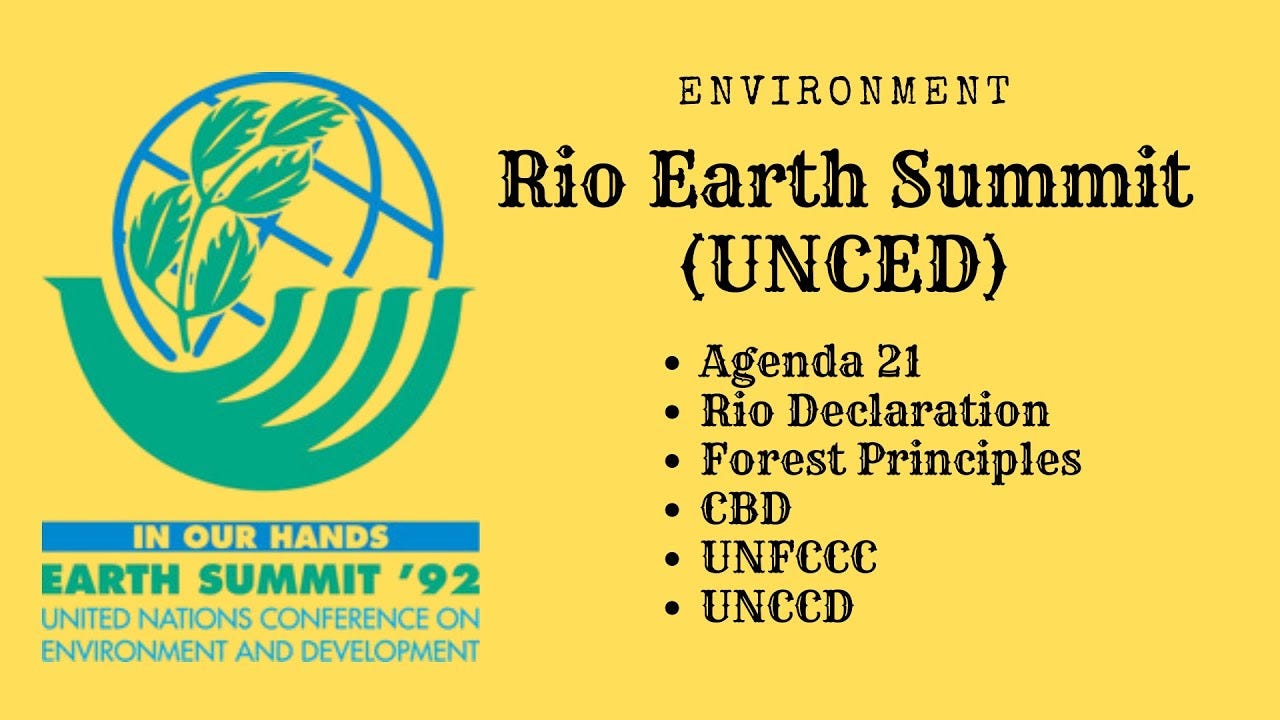
Rio Earth Summit took place in 3 Jun 1992–14 Jun 1992, exactly 30 years ago. Some of the key outcomes were the UNFCCC and CBD (source: UNEP)
Postmortem of Earth Summit 1992
Today, the UNFCCC resulted in the world tackling the challenge to reduce the total emission of carbon dioxide and other greenhouse gases. This means lowering the usage and demand of human activities that produces high amounts of carbon dioxide, such as transportation, electricity, construction and cows before it becomes too late to limit the 1.5 degree C rise in temperature.
As the window in doing so is rapidly closing, every action is a victory for our future generations. The COP21 in Paris in 2015 is one such example, sprouting unified commitments from countries and enterprises to become carbon neutral over a period of time. New initiatives, including carbon credits and CO2 trackers, started to arise as businesses found innovative ways to monetize. This led to a growing body of UX designers and startups actively working in this space.
Regrettably, less can be said about CBD on biodiversity. Scientists are sounding out the sixth mass extinction. Professor Tommy Koh, former chairman of the preparatory committee for the Earth Summit in 1992, recently declared that the CBD has been a failure. The consequences are dire due to the network effect of the natural world. As one organism perishes, the others are affected, and they eventually disappear too. Think about the destruction of rainforest leading to the loss of habitat and extinction of wildlife. The irony behind short term human gains is the dependency of natural ecosystem to strengthen the fertility of the land over the long run. Such thinking needs to be applied on a global context with a greater emphasis.
More than just 1 and 0
Or perhaps there could be some binary thinking at play here. 1 or 0. Yes or no. This or that. Physical or Digital. Nature or human. Having limited options is not necessarily bad (refer to Paradox of Choice), but oversimplifying a complex problem runs a risk of favouring or emphasizing one thing over the other. It also ignores the possibility of other solutions. What about having a combination of both option, or considering the third option and so on?
Which begs the question: could humans and nature actually coexist together?
Singapore: a biodiverse nation
Within 10 years, Singapore planted over 55,000 new trees, and has continued the tree planting tradition yearly. Today, the nation has transited with a new vision: “City in Nature”, promoting initiatives, such as nature corridors for wildlife crossings, and repopulating indigenous species back into their habitats.
Singapore latest Green Plan 2030 includes its new vision on the City in Nature (source: Npark)
Biophilic UX
However, this phenomenon of nature providing additional benefits and wellbeing is not new. In the 1980s, biologist Edward O. Wilson introduced the “biophilia” concept, which states that humans have an innate, biological affinity for the natural world. Since then, there has been a rise in natural applications into the human environment through what is known as “biophilic design”.
The forerunners in the practices were the architects, incorporating greenery into buildings and spatial design. Subsequently, through awareness, other industries started catching on. Hospitals started incorporating natural lighting, wood and greenery into interior spaces. Tech companies brought in their planter boxes and green walls in hope to raise the morale of their employees through “attention restoration” theories of mental breaks. Some companies have even created a mini rainforest within their premises, by potting hundreds of plants in unutilized spaces.
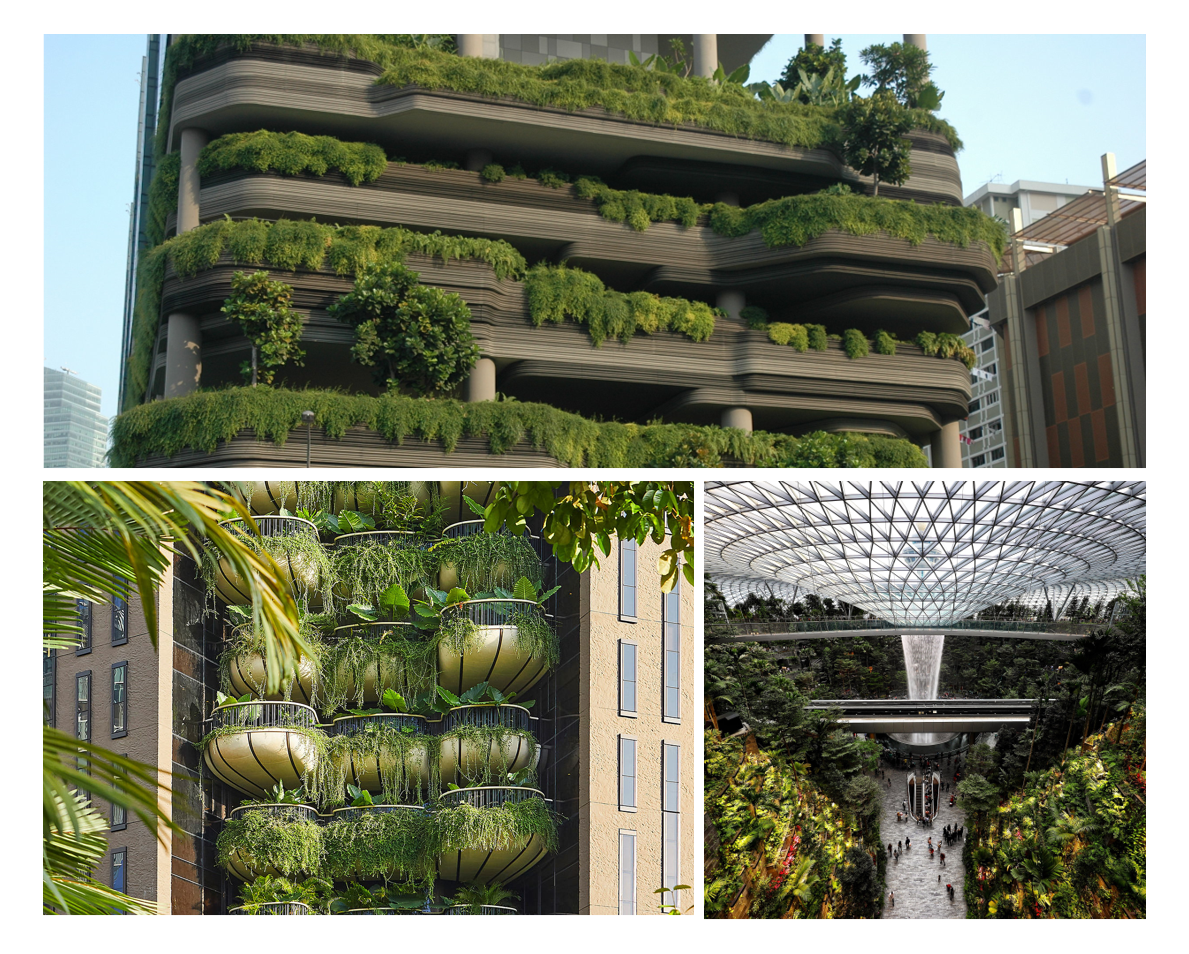
From bottom left clockwise: Notable biophilic architecture in Singapore by Thomas Heatherwick, WOHA and Moshe Safdie
So even if there is a possible case for nature and human to live together, a leading question emerges: could digital technology play a role in the natural environment? Could digital solution enlighten their users, such that they create an appreciation for nature and biodiversity?
I believe this is possible and there are increasing number of innovative solutions to learn from. For the rest of the article, I would like to provide examples of how 5 visionaries offer their unique perspective of biophilic UX.
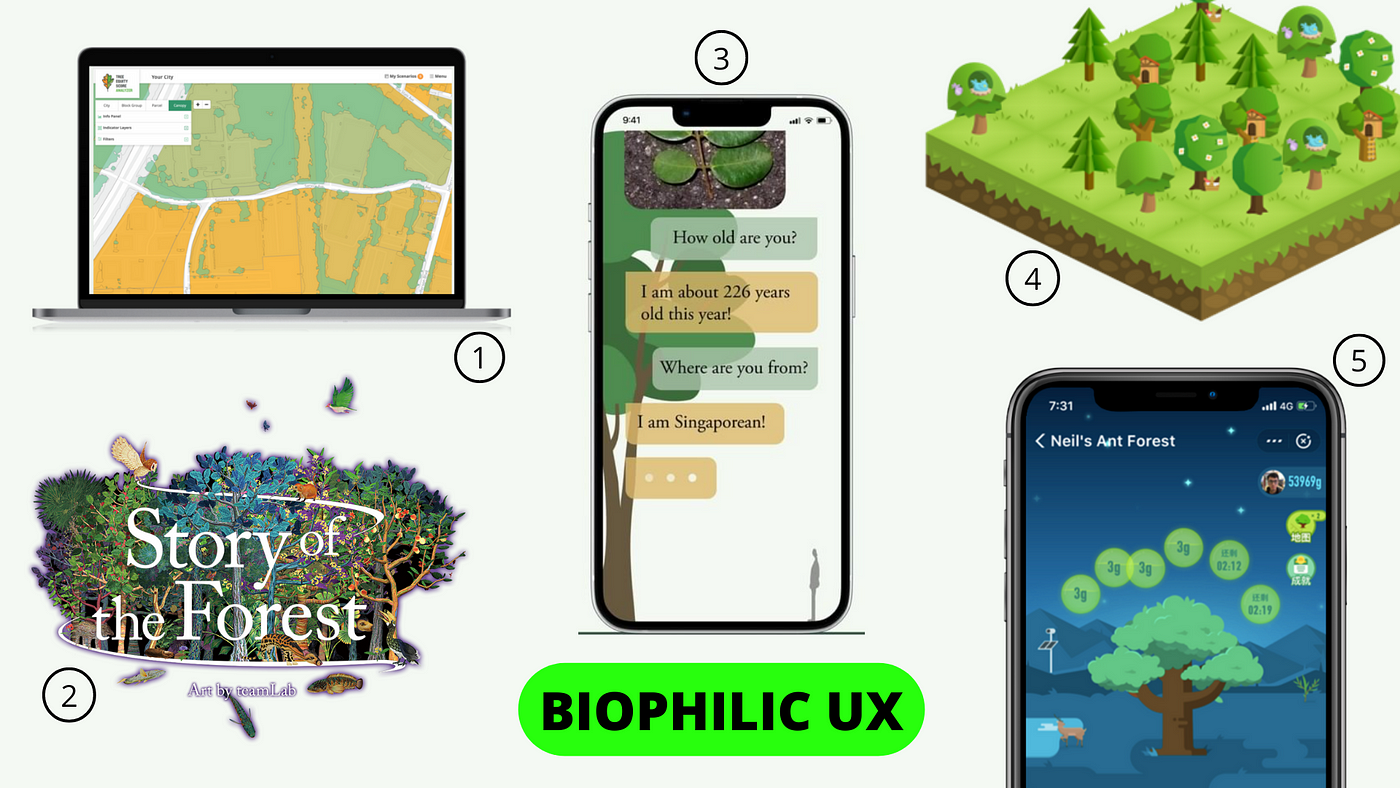
5 biophilic UX solutions for a sustainable future
1. Tree Equity Score by American forest
What if trees and shade are an indicator on how diverse, equitable and inclusive (DEI) your neighborhood is? Tree Equity Score (TES) is an web based map solution that provides an overview of the density of tree canopy and surface temperature based on income, employment, race, age and health factors in the U.S. Zones are demarcated based on natural tones from yellow to green; the greener the zone, the higher your TES is. Action can thus be taken through the democratization and better visualization of the data made available to the public.
A snapshot of the Tree Equity Scores (Source: American Forests)
2. Story of the forest by teamLab
What if stories can come to life through experiential design? teamLab is an interdisciplinary art collective originating from Japan, and they have created an interactive digital installation in the National Museum of Singapore. Blending the native flora and fauna of Singapore and South East Asia with the walls of the Glass Rotunda, teamLab has created a digital landscape of day and night, as well as dry and wet seasons of Singapore. Users interact with the artwork through movement, resulting in new forests and animals reappearing whilst digital flowers fall from the top of the installation. Overall, the Story of the Forest recaptures the imagination of their visitors of what a healthy local forest would be like.
Story of the Forest is an immersive installation that transforms 69 drawings from the William Farquhar Collection of Natural History Drawings into three-dimensional animations. (source: NHB)
3. Treeline by Nysha Tan
What if we can speak to trees so as to learn more about them? Treeline is a design thesis from graduating student Nysha Tan (@cloudsalad) of National University of Singapore. Tapping on to her childhood practices of addressing trees with respect and through her observation of static memories as photos, she has attempted to expand our interaction with trees through the use of geo-caching, conversational UX and gamification. The application offers users the opportunity to get to know trees like how they get to know a person. As they unlock the hidden histories of trees, the public forms communities by contributing to a tree’s living history. Treeline achieves biophilia by enriching the encounter with trees, and creates an emotional and social connection with trees through the use of digital technology.
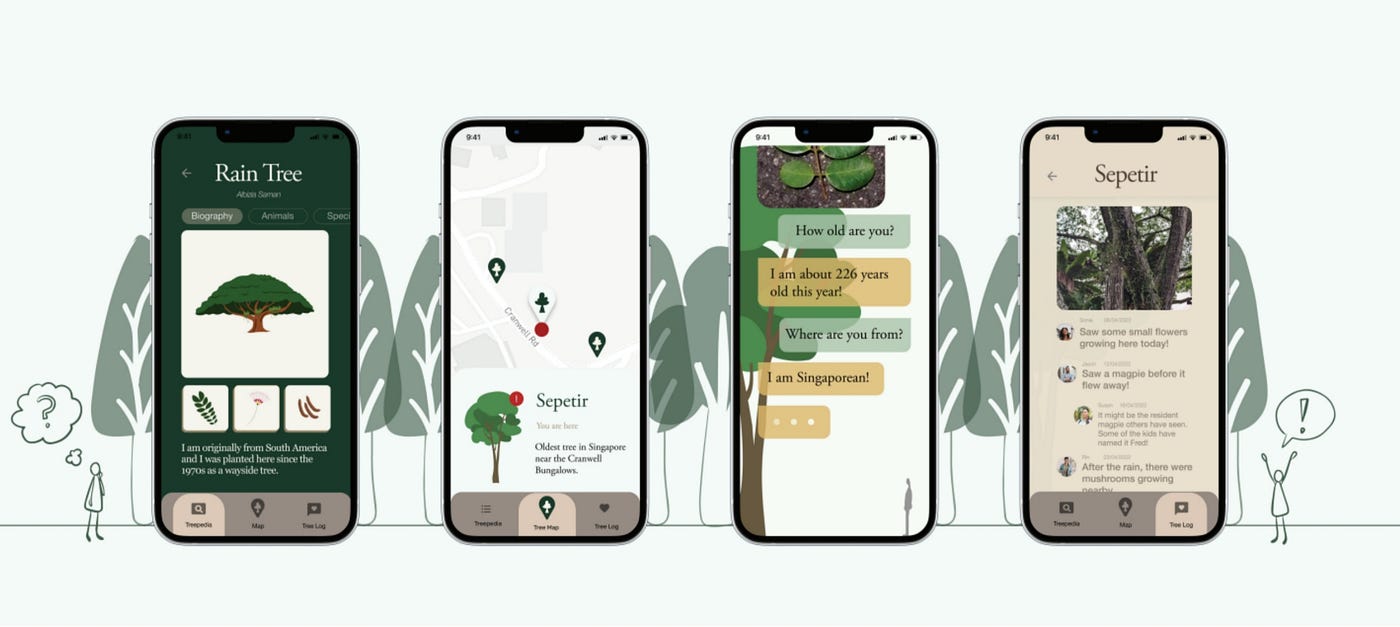
From left to right: Treeline provides information about trees. They can locate and interact with the trees to learn more about the tree’s history. Lastly, the public has a chance to contribute to a tree’s living history
4. Forest app by seekrtech
What if we could create forests by spending more time to focus? Taiwanese startup seekrtech created the Forest app by linking rewards through repetitive desired actions with the use of behavioural science. Through a simple UI, users can plant and grow trees by staying focus in an innovative timer application. But what makes this solution even more meaningful is how they have partnered with NGO real-tree planters, Trees for the Future, to plant actual trees through virtual coin donation from Forest’s users. To date, a total of over 2 million trees have been planted in Africa through the Forest App.
Simple timer application to allow you to focus (source: Forest App)
5. Ant forest by Alibaba
What if our collective action of reducing carbon footprint also results in the growth of new forests? Enter the Chinese tech giant, Alibaba, with their world changing solution of Ant Forest. Unlike other tech companies, who treats biophilia as an add-on, Alibaba decided to tackle the issue directly, by creating a fun and social interaction with Alipay users. Users are rewarded with “green energy points” each time they take a step to reduce their emissions, such as by biking to work, going paperless and buying sustainable products. Friends can help to water trees or “steal” energy from, each other. Tree owners can also view images of their own trees in real-time via satellite. In 2021, a whooping 326 million real trees, roughly the size of 390,000 soccer fields, or the size of 3 Singapore and its surrounding waters included. Imagine 3 entire nation entirely filled with trees from one end to the other. (it’s not hard to imagine when you consider neighbouring island Batam and Bintan, with their water bodies included) All through the active participation and conscious act of digital users on their phone.
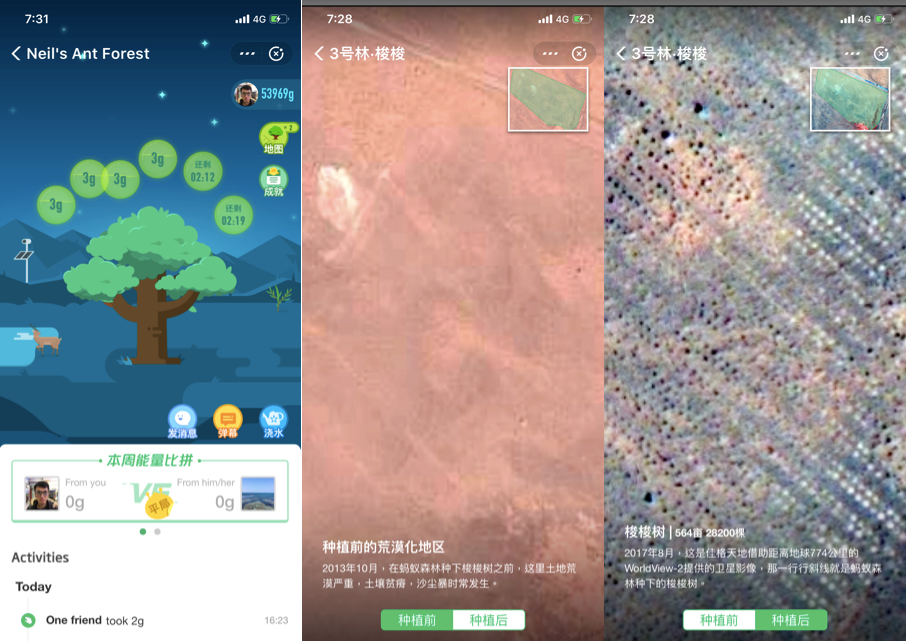
From barren land in Inner Mongolia to tree planting, Alipay Ant Forest users can see satellite images of their trees in real-time. (Source: Alizila)
Recommend
About Joyk
Aggregate valuable and interesting links.
Joyk means Joy of geeK